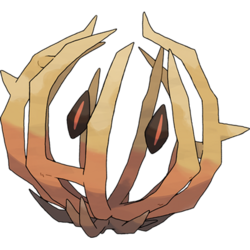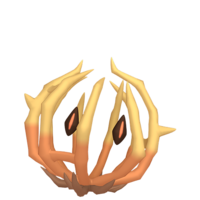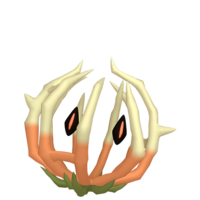From Bulbapedia, the community-driven Pokémon encyclopedia.
|
|
| Line 245: |
Line 245: |
|
| |
|
| ===Origin=== | | ===Origin=== |
| Bramblin appears to be based on {{wp|tumbleweed}}s — certain types of plants which, when mature, have most of their cells dry out and die so that the wind can pick them up and allow them to disperse their seeds, hence Bramblin's {{t|Ghost}} type and Ability. Bramblin's secondary Ghost type may also be derived from the association of tumbleweeds with {{wp|ghost town}}s and empty deserts. | | Bramblin appears to be based on {{wp|tumbleweed}}s — certain types of plants which, when mature, have most of their cells dry out and die so that the wind can pick them up and allow them to disperse their seeds, hence Bramblin's {{t|Ghost}} type and Ability. Bramblin's secondary Ghost type may also be derived from the association of tumbleweeds with {{wp|ghost town}}s and empty deserts. Its eyes resemble tumbleweed seeds and the two thorns on its sides give the impression of {{wp|devil}} horns. |
|
| |
|
| Bramblin's cry is reminiscent of the whistling sound at the beginning of {{wp|The Good, the Bad and the Ugly (theme)|the theme from}} ''{{wp|The Good, the Bad and the Ugly}}'', perhaps alluding to the tumbleweed being a common sight in {{wp|spaghetti Western}} movie scenes. Bramblin not knowing where it is going may reference the drifter character archetype that is a staple of the Western genre. | | Bramblin's cry is reminiscent of the whistling sound at the beginning of {{wp|The Good, the Bad and the Ugly (theme)|the theme from}} ''{{wp|The Good, the Bad and the Ugly}}'', perhaps alluding to the tumbleweed being a common sight in {{wp|spaghetti Western}} movie scenes. Bramblin not knowing where it is going may reference the drifter character archetype that is a staple of the Western genre. |
Revision as of 20:43, 4 September 2023
Bramblin (Japanese: アノクサ Anokusa) is a dual-type Grass/Ghost Pokémon introduced in Generation IX.
It evolves into Brambleghast when leveled up while outside of its Poké Ball after the player walks 1000 steps using the Let's Go! feature.[1][2]
Biology
Bramblin is a Pokémon that resembles a tumbleweed. It has small, rhombic, black, leaf-like eyes with thin red pupils that float inside its body, which itself comprises brownish yellow, jagged, thorny plant stalks that point up and curl slightly inward to form a spherical shape. The eyes don't blink and instead flip and rotate to express Bramblin's emotions. The stalks are held together by what appears to be the remnants of roots on the underside of its body.
Bramblin are created when wandering souls unable to move on get tangled and fused to dried grass. Bramblin's main form of locomotion is the wind, which blows it uncontrollably to destinations unknown. Bramblin despises getting wet. It makes its habitat in dry, rocky regions such as deserts.
Bramblin and its evolution, Brambleghast, are the only known Pokémon that can have Wind Rider as an Ability.
Evolution
Bramblin evolves into Brambleghast.
In the anime
Major appearances
Minor appearances
In the manga
In the TCG
- Main article: Bramblin (TCG)
Game data
Pokédex entries
| This Pokémon was unavailable prior to Generation IX.
|
| Generation IX
|
|
|
Paldea
#242
|
| Scarlet
|
A soul unable to move on to the afterlife was blown around by the wind until it got tangled up with dried grass and became a Pokémon.
|
| Violet
|
Not even Bramblin knows where it is headed as it tumbles across the wilderness, blown by the wind. It loathes getting wet.
|
|
|
Game locations
| This Pokémon was unavailable prior to Generation IX.
|
|
|
In side games
Held items
Stats
Base stats
| Stat
|
Range
|
| At Lv. 50
|
At Lv. 100
|
40
|
|
100 - 147
|
190 - 284
|
65
|
|
63 - 128
|
121 - 251
|
30
|
|
31 - 90
|
58 - 174
|
45
|
|
45 - 106
|
85 - 207
|
35
|
|
36 - 95
|
67 - 185
|
60
|
|
58 - 123
|
112 - 240
|
Total: 275
|
Other Pokémon with this total
|
- Minimum stats are calculated with 0 EVs, IVs of 0, and (if applicable) a hindering nature.
- Maximum stats are calculated with 252 EVs, IVs of 31, and (if applicable) a helpful nature.
|
Type effectiveness
| Under normal battle conditions in Generation IX, this Pokémon is:
|
|
|
|
|
|
|
|
|
|
|
|
|
Learnset
|
|
|
|
- Bold indicates a move that gets STAB when used by Bramblin
- Italic indicates a move that gets STAB only when used by an Evolution of Bramblin
|
|
|
|
|
- Bold indicates a move that gets STAB when used by Bramblin
- Italic indicates a move that gets STAB only when used by an Evolution or an alternate form of Bramblin
|
|
|
|
|
- Moves marked with an asterisk (*) must be chain bred onto Bramblin
- Bold indicates a move that gets STAB when used by Bramblin
- Italic indicates a move that gets STAB only when used by an Evolution of Bramblin
|
Side game data
Evolution data
Sprites
| This Pokémon was unavailable prior to Generation IX.
|
|
|
|
|
Trivia
Origin
Bramblin appears to be based on tumbleweeds — certain types of plants which, when mature, have most of their cells dry out and die so that the wind can pick them up and allow them to disperse their seeds, hence Bramblin's Ghost type and Ability. Bramblin's secondary Ghost type may also be derived from the association of tumbleweeds with ghost towns and empty deserts. Its eyes resemble tumbleweed seeds and the two thorns on its sides give the impression of devil horns.
Bramblin's cry is reminiscent of the whistling sound at the beginning of the theme from The Good, the Bad and the Ugly, perhaps alluding to the tumbleweed being a common sight in spaghetti Western movie scenes. Bramblin not knowing where it is going may reference the drifter character archetype that is a staple of the Western genre.
Name origin
Bramblin may be a combination of bramble and rambling, goblin, or gremlin.
Anokusa may be derived from the phrase あの草 ano kusa (that grass).
In other languages
| Language
|
Title
|
Meaning
|
 Japanese Japanese
|
アノクサ Anokusa
|
From あの草 ano kusa
|
 French French
|
Virovent
|
From virevoltant and virer au vent
|
 Spanish Spanish
|
Bramblin
|
Same as English name
|
 German German
|
Weherba
|
From Wehe, woher, and Latin herba
|
 Italian Italian
|
Bramblin
|
Same as English name
|
 Korean Korean
|
그푸리 Geupuri
|
From 그 풀 geu pul
|
 Mandarin Chinese Mandarin Chinese
|
納噬草 / 纳噬草 Nàshìcǎo
|
From 納 / 纳 nà, 噬 shì, 草 cǎo, and a pun of 那是草 Nà shì cǎo
|
 Cantonese Chinese Cantonese Chinese
|
納噬草 Naahpsaihchóu
|
From 納 naahp, 噬 saih, and 草 chóu
|
|
|
|
| More languages
|
 Thai Thai
|
อาโนะคุสะ Anokhusa
|
Transcription of Japanese name
|
|
|
|
Related articles
Notes
External links

|
This Pokémon article is part of Project Pokédex, a Bulbapedia project that aims to write comprehensive articles on each Pokémon species, as well as Pokémon groups and forms.
|
 For other sprites and images, please see Bramblin images on the Bulbagarden Archives.
For other sprites and images, please see Bramblin images on the Bulbagarden Archives.

















